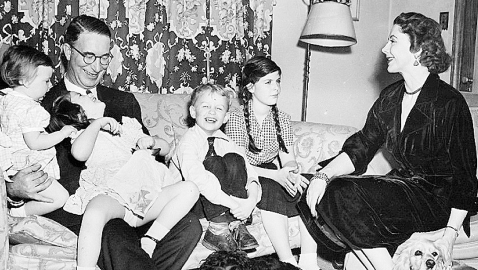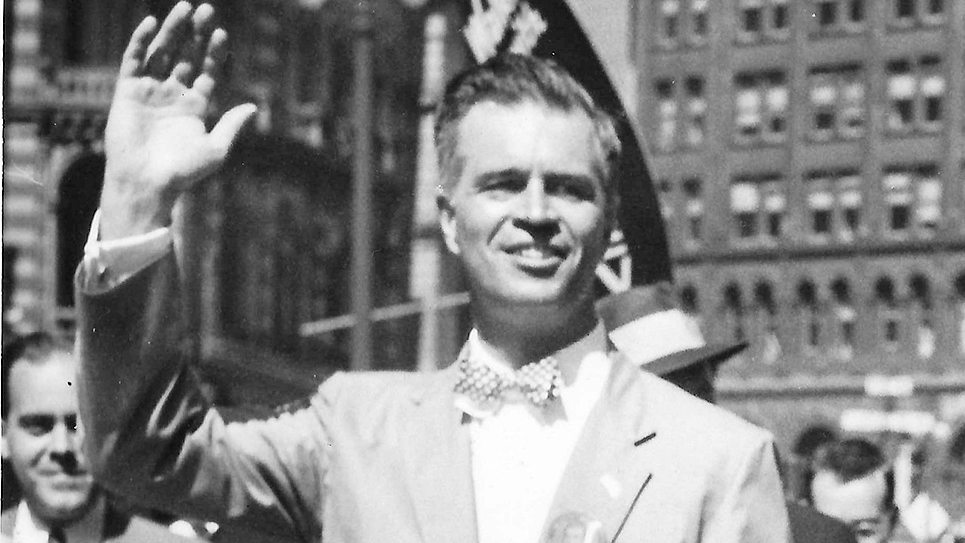Tennessee’s Senator Estes Kefauver had once again bid for the Democratic presidential nomination in 1956. Unlike 1952, Kefauver had encountered stiff competition from various other candidates. Former Illinois governor and 1952 Democratic presidential nominee Adlai Stevenson had not been coy or hesitant as he had been four years earlier. Stevenson wanted the 1956 nomination and fought for it.
Kefauver had ended his presidential campaign before the 1956 Democratic National Convention and after yet another desperately hard fought floor fight, emerged as the vice presidential nominee. Exhausted, Kefauver and his advisors sadly concluded they were in serious debt; the tab for the Chicago convention was $85,000 alone and did not account for the debt from the primaries. Noble Caudill, a wealthy Tennessee businessman, served as the financial angel for Estes Kefauver, as well as an important fund raiser for Tennessee governor Frank Clement. Caudill wearily made the rounds before the close of the convention, seeking money from prominent Democratic donors. He recalled for Kefauver’s biographer Charles Fontenay that he had the necessary funds within hours.
Senator Kefauver and his wife flew home to Tennessee, landing in Nashville where they received a warm welcome from the home folks. Not every Tennessean returning from the Democratic National Convention was warmly received at the airport. Governor Clement had actually been booed by those awaiting Kefauver; perhaps even worse, Senator Albert Gore found the lobby quite nearly empty and only Nashville Congressman J. Percy Priest seemed to know who he was.
After resting briefly in Tennessee, Kefauver would yet again hit the campaign trail and according to his biographer Charles Fontenay, he would make appearances in thirty-eight states, two hundred and ten towns and cities, and make four hundred and fifty speeches.
Kefauver’s style of campaigning, shaking every possible hand, spending time chatting one-on-one, visiting with anyone who crossed his path, made it virtually impossible for his advance team to keep the senator on schedule. Stevenson, a nervous sort of person, recognized as highly intellectual, was frequently annoyed by his running mate’s turtle-like pace, but the professional politicians inside the Democratic Party recognized Kefauver’s effectiveness. Lyndon Johnson, Majority Leader of the United States Senate, and one of the best politicians in American history, referred to Estes Kefauver as, “the greatest campaigner of them all.”
Senator Kefauver campaigned heavily in the Midwest and Western United States, where he was quite popular. More than a few Democrats grumbled that Kefauver should have been the presidential nominee. Kefauver dogged the incumbent Vice President, Richard Nixon, who lived in the same Washington, D. C. neighborhood as the Tennessean. The two traded verbal blows throughout the campaign and Nixon finally complained Kefauver was hitting “below the belt” and using “low-road tactics.”
Kefauver was in Miami, Florida on the day of the election, personally working the polls before heading back to Washington to watch the results with family and friends. The Republican ticket of President Dwight D. Eisenhower and Richard Nixon easily prevailed. To Kefauver’s dismay and horror, even Tennessee voted for Eisenhower and Nixon. Eisenhower had carried Tennessee in 1952, but Kefauver had not been on the Democratic ticket that year and losing his home state was an embarrassment to the senator.
Senator Kefauver himself attributed the defeat of the Stevenson – Kefauver ticket to a flare up in the Middle East, but the truth is Eisenhower remained the most popular person in the country and no Democrat could have beaten him.
It was the last time Estes Kefauver would run for national office.
Kefauver’s failed 1956 campaign left him dispirited and his biographer Charles Fontenay relates that the primary contests had “eroded Kefauver’s confidence in his direct appeal to the voters”. Kefauver was also aware despite having crushed Congressman Pat Sutton’s bid to replace him in the United States Senate, Frank Clement, running against the once formidable Gordon Browning, had run some forty thousand votes ahead of him.
Clement was the first governor in Tennessee history to serve a four-year term; before 1954, Tennessee governors could run for and serve three two-year terms. Few managed to secure the elusive third two-year term. Clement had been elected in 1952, served for two years, then was reelected in 1954 for a four-year term. Some Kefauver supporters had been nervous Clement would forgo seeking reelection in 1954 and instead run against the senator. Friends of Senator Albert Gore were even more nervous in 1958 as Clement’s term as governor was coming to a close and it was readily apparent Clement did not relish the idea of private life. After some consideration, Clement announced he would not run against Senator Gore in 1958, but there was the possibility of his challenging Kefauver in 1960.
The contrast in appearance and style between Estes Kefauver and Frank Clement was significant. Tall, lean, bespectacled, and a poor speaker, Kefauver still managed to evoke almost fanatical loyalty from friends. Frank Clement, handsome, vital, and renowned for his ability as an orator, inspired no less loyalty from many thousands of Tennesseans. It was quite clear despite his retirement in 1958, Frank Clement was not through with elective office and a clash between the two seemed inevitable.
Many Democrats sincerely believed Estes Kefauver would run for the presidential nomination again in 1960. President Eisenhower could not be a candidate to succeed himself in 1960 and many Democrats thought Kefauver, should he run, would be the front runner for the nomination. Even Adlai Stevenson exclaimed, “He won’t run again? Give me half an hour with him!”
Clement’s successor as governor was Buford Ellington, who had served in Frank Clement’s administration. Ellington had only barely won the Democratic nomination in a field of serious candidates and while Ellington and Clement “leap frogged” as Tennessee’s chief executive, many did not realize the two men were growing apart. Ellington was considerably more conservative in his political outlook than the populist Frank Clement. Neither Governor Ellington nor his administration were especially friendly to Senator Estes Kefauver. Ellington also likely knew that Kefauver had actually briefly considered running for governor himself in 1958. Kefauver would have been able to hold his Tennessee base and compete for the Democratic presidential nomination in 1960 without having to run for office at home. Kefauver loyalists had supported Edmund Orgill, the Mayor of Memphis after the death of E. H. Crump. Orgill had been one of Kefauver’s original supporters in his 1948 race, when defying the Memphis Boss had not been an easy thing to do.
Orgill fell only some ten thousand votes short of winning the gubernatorial nomination, which would have guaranteed Kefauver of a friendly administration. Yet in a field of eight contenders, Buford Ellington emerged the winner with slightly more than thirty-one percent of the vote.
Ellington’s victory left Estes Kefauver little choice but to abandon any hope of running for president in 1960. Kefauver’s term in the Senate was due to expire and he would almost certainly face serious opposition for reelection. Kefauver had long wanted to serve on the Senate Foreign Relations Committee, one of the more prestigious assignments in the United States Senate. Many senators crave the opportunity to serve on the Foreign Relations Committee for its prestige and membership on that particular committee brought a heavy social calendar with it, as foreign embassies fervently courted those senators in a position to help their own company. Despite the supposed prestige of the Foreign Relations Committee, it rarely ever boosted the popularity of any senator back home. In fact, it usually had quite the opposite effect. Tom Connally, senator from Texas, had long been interested in foreign affairs and served as Chairman of the Foreign Relations Committee and as he aged and the 1952 election approached, an opponent appeared and began making speeches all over the Lone Star state and told folks old Senator Connally was more interested in Europe and Asia than Texas. Connally decided to retire. The very same thing happened to one of the most revered members of the United States Senate, Walter F. George of Georgia. As George prepared to run for reelection in 1956, he was Chairman of the Senate Foreign Relations Committee. Herman Talmadge, former governor of Georgia, was critical of George’s interest in foreign affairs, intimating George was not focused on the needs of Georgia and Georgians. Walter George opted to retire than run against Talmadge.
Senator Kefauver, realizing the political realities, told Senator Majority Leader Lyndon Johnson, he was giving up his ambition to serve on the Senate Foreign Relations Committee and would prefer an assignment on the Appropriations Committee. It was a far more practical assignment for a senator running for reelection. Tennessee’s late Senator K. D. McKellar had enjoyed a long reign on the Appropriations Committee and he had showered Tennessee with billions of dollars in federal money. No Tennessean had served longer in the United States Senate than Kenneth D. McKellar (he still holds the record to this day).
“It would help my situation down home,” Kefauver told Johnson.
Kefauver’s assignment to the Senate Appropriations Committee had an immediate effect on Tennessee politics. Frank Clement understood politics just as well as anyone and the enormously powerful Majority Leader’s interest in Estes Kefauver meant that should he manage to beat Kefauver in 1960, he might find a displeased LBJ an obstacle too difficult to overcome. Soon Clement was sending signals that he would run for governor again in 1962 rather than seek Kefauver’s seat in the United States Senate.
Still, Estes Kefauver encountered opposition inside the Democratic primary. Judge Andrew “Tip” Taylor announced he would run against Kefauver in 1960. Taylor had served on Tennessee’s Public Service Commission, running successfully in 1946 with Governor Jim Nance McCord and Senator K. D. McKellar. Taylor had also served as a judge in Jackson, Tennessee and quite nearly beat Buford Ellington for the 1958 gubernatorial nomination. Taylor had run about a thousand votes ahead of Edmund Orgill to finish second.
Taylor went to see Governor Ellington who expansively offered his personal support and that of his administration. Ellington went so far as to say he would endorse Taylor before the end of the campaign.
Andrew Taylor had all the makings of a formidable challenger. The 1960 campaign would be the last of Estes Kefauver’s long career.
Stories in this Week's Focus
- The Knoxville Focus for July 14, 2025
- Publisher’s Positions
- District 1 candidates answer Focus questions
- Michigan’s Governor G. Mennen Williams
- Annual KFOA Media Day event ‘kicks off’ the season
- ‘It was tied when we started’
- The Knoxville Focus for July 7, 2025
- Publisher’s Positions
- Famous Grainger Co. Tomato Festival coming soon
- Augustus O. Stanley of Kentucky







